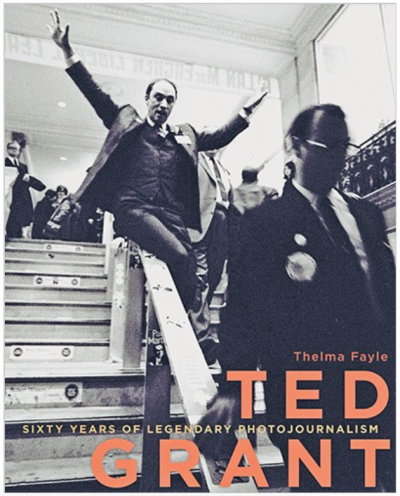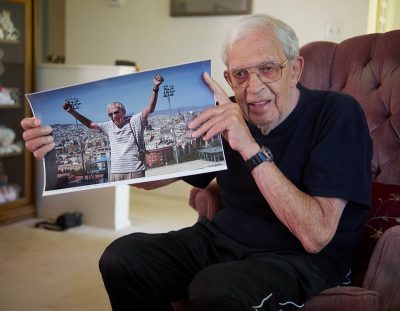By Randy Boswell
The recent death of renowned Canadian photojournalist Ted Grant — who taught his craft at the School of Journalism and Communication for nearly a decade beginning in 1972 — has prompted nationwide tributes for the man who famously captured a shot of Pierre Trudeau sliding down a banister at the 1968 Liberal leadership convention that made him Canada’s prime minister.
Grant died at a hospital in Victoria on April 19 at age 90.
“He lived a lot of lives in one,” his son Scott, an Ottawa photographer, told CBC News last week for a story that recounted highlights of Grant’s award-winning, 60-year career — most of it spent as a freelancer.
“He took pictures of era-defining events and people,” noted the story, “from the Vietnam War and the meltdown at the Chernobyl nuclear power plant, to former U.S. president John F. Kennedy and Canadian sprinter Ben Johnson crossing the Olympic finishing line.”
Library and Archives Canada and the National Gallery of Canada hold more than 280,000 of Grant’s images, the largest such collection of any Canadian photographer’s work.
He is “widely regarded as the father of Canadian photojournalism,” according to the National Gallery. “Ted Grant has been a seminal figure since the start of his career in 1951. He was instrumental in shaping Canadian newspaper photography, as he was one of the first photographers to use 35mm film, which would become the industry standard.”
Between 1957 and 1971, Grant worked as a freelance photographer for the National Film Board’s still photography division.
In a note about Grant’s photographic style, the gallery states: “Grant prefers to shoot without a flash from the shadow side of a subject to give side-back lighting, a technique inspired largely by Rembrandt’s paintings.”
In her 2013 biography Ted Grant: Sixty Years of Legendary Photojournalism, author Thelma Fayle recalled how “Ted had been approached to teach the class at Carleton by (J-School director) Joe Scanlon, a well-known Canadian reporter, shortly after the Munich Olympics. It was a gig that lasted almost nine years.
“Ted proposed to the large class that it might be fun if they divided into two groups to have a friendly competition that would simulate the competitive environment they would soon enter. Each semester, the ‘Hot Shots’ and the ‘Charlie Browns’ set off to outdo each other.”
Fayle quoted Grant describing his passion for photojournalism — a passion shared with hundreds of Carleton students over the years.
“Taking pictures offers you the coolest life you can imagine,” he once said. “You are constantly alive with seeing the world differently. Photojournalism has taken me around the world. It gave me a magical career.”
When he became a member of the Order of Canada in 2016, Grant’s citation lauded his achievements as “a premier photojournalist who captures Canadian culture and social history through his lens,” and noted that he is “generous with his time, as an instructor and mentor to young, aspiring photographers.”

Cover of Thelma Fayle’s 2013 biography of Ted Grant, showing the photographer’s most famous picture — Pierre Trudeau sliding down a bannister, 1968.

Ted Grant, shown here in 2016, holds a photograph of himself from a 2012 trip to Barcelona, where he had shot pictures at the Olympic Games twenty years earlier. (Photo by Peter Klein)
Thursday, April 30, 2020 in General, Journalism News
Share: Twitter, Facebook



